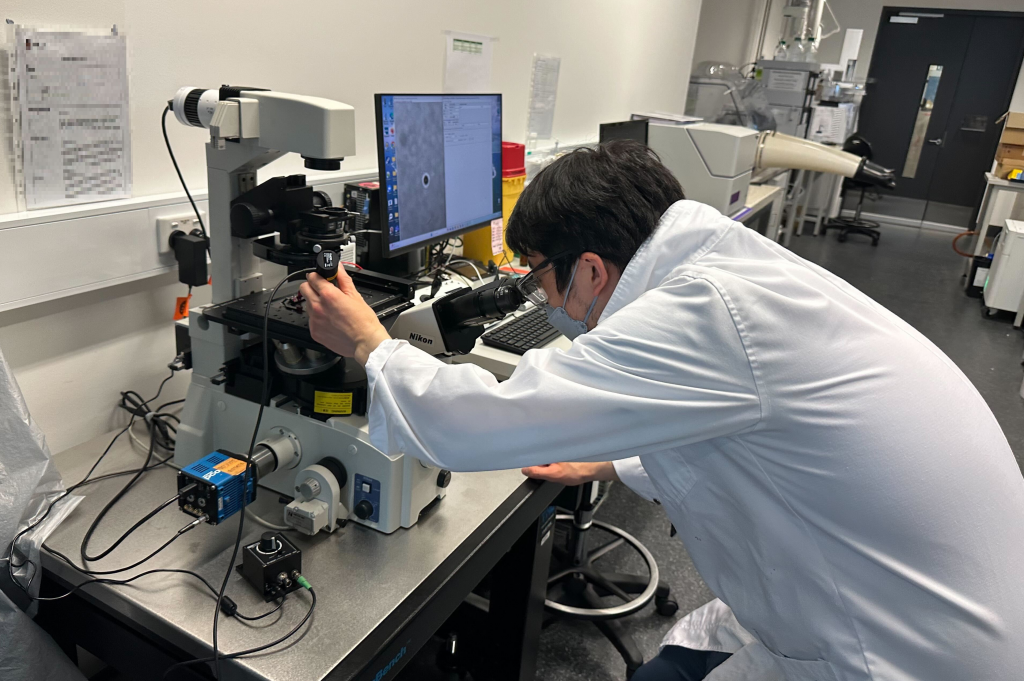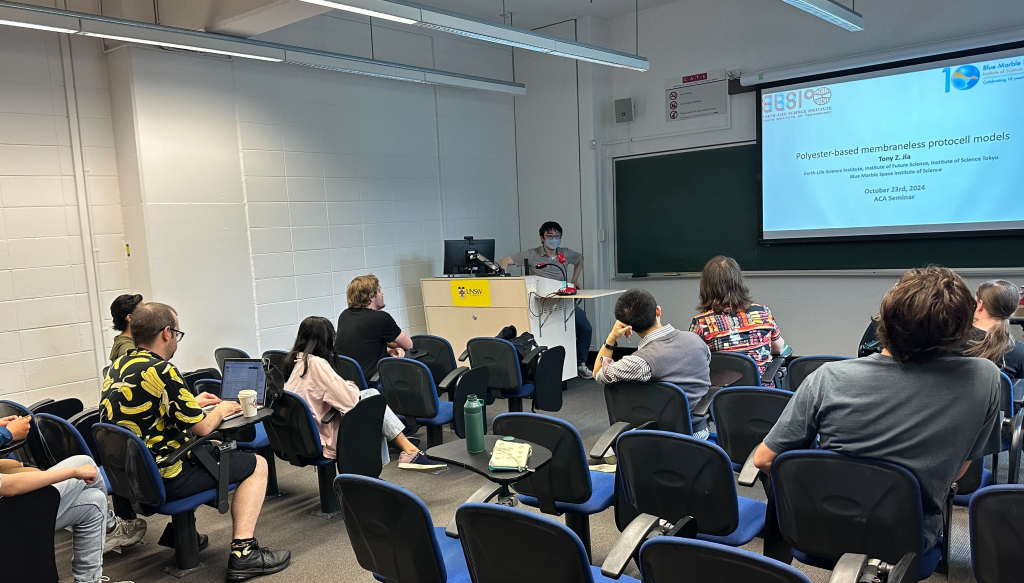2024.11.07
【WRH】Specially Appointed Associate Professor Tony Z. Jia visited the UNSW-Sydney in Australia
Specially Appointed Associate Professor Tony Z. Jia has returned from his stay in Australia supported by the WRH Faculty Research Abroad Program. This is a report on the activities and results of his stay.

Fig. 1_Tony Z Jia, conducting research using a digital holographic microscopy at Wang Lab
| Awardee | Tony Z. Jia, Specially Appointed Associate Professor, Earth-Life Science Institute, Institute of Future Science |
| Destination | UNSW-Sydney |
| City and Country | Sydney, NSW, Australia |
| Name and Position of Host Researcher | Anna Wang, Senior lecturer |
| Travel Period | 2024/10/08 – 2024/10/30 (23 Days) |
| Project Title | Digital Holographic Microscopy to Observe Polyester Protocell Motion |
Understanding the origins of life involves combining research from many disparate fields, including astronomy, planetary science, geology, chemistry, biology, and many more! One aspect of the origins of life is understanding the origin and evolution of the first cells on Earth, which may have eventually led to emergence of modern cells and biology. There are many possible structures that primitive cells, or protocells, could have taken. For example, given that modern cells contain a lipid bilayer, lipid vesicles have been proposed as one protocell model. However, could a different type of protocell have existed before the emergence of membranes? In 2019, Jia, et al. was part of a team based at the Earth-Life Science Institute, Institute of Future Science, Institute of Science Tokyo which discovered that polyester gels could be polymerized through simple dehydration synthesis of alpha hydroxy acid (AHA) monomer (a prebiotically plausible chemical) solutions, and upon further rehydration, the polyesters could form membraneless droplets. We have previously characterized many structural and functional aspects of polyester protocells, which led us to propose polyester microdroplets as plausible membraneless protocells. Here, during this research visit, we sought to initiate collaboration and discussion with the Wang Lab at UNSW-Sydney, experts in assembly, structure, and function of protocells, to further characterize polyester microdroplets.
During the visit, Tony participated in group meetings, and was able to meet and discuss research interests with lab members, including students. Topics discussed included vesicle formation, liquid-liquid phase separation, self-assembly, nanofibrils, molecular dynamics simulations, lipid bilayer dynamics, and others. The result of these meetings led to the potential for future collaborations with various lab members, as well as an introduction to the various techniques used by the Wang lab, including the digital holographic microscopy system pioneered by the Wang Lab (Figure 1). In particular, holographic microscopy is a technique that allows 3-D tracking of motion by small particles, which we believed was relevant to characterize the motion and growth (via coalescence) of the polyester microdroplets. From now, we hope to develop this collaboration further to be able to observe in fine detail polyester microdroplet dynamics that could give clues into their role at the origins of life.
In addition to the host lab and their members, Tony was able to meet other researchers at UNSW-Sydney and discussed topics and potential collaborations related to astrobiology, biophysics, and organic chemistry. Specifically, Tony gave a presentation at the Australia Centre for Astrobiology (ACA) weekly seminar, which is the pre-eminent origins of life and astrobiology organization in Australia, a country with a long history of supporting astrobiology and origins of life research (Figure 2). This seminar led to a number of questions and deep discussion, which could lead to future collaboration (and student interest in the ELSI graduate course) in the future. Specifically, Tony received a visiting scholar position during his stay (for the rest of 2024), which he hopes will be helpful to facilitate future collaborative work. Future work will focus on optimization of the polyester system to be applied to digital holographic microscopy. We also hope to develop new partnerships with the ACA, and also apply for joint grants to continue the collaboration (such as WRH visiting fellowships).

Fig. 2_Tony Z Jia, giving a presentation at the ACA weekly seminar
Related links:
– World Research Hub (WRH) Program
– Jia, Tony Z (Earth-life Science Institute)

